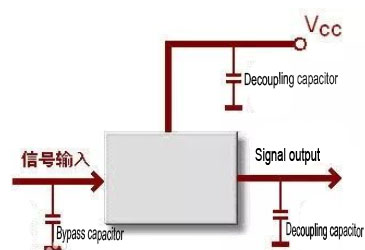The bypass capacitors is a capacitor that can bypass and filter high frequency components in alternating current mixed with high frequency current and low frequency current.
The main function of the bypass capacitors is to generate an AC shunt to eliminate unnecessary energy that enters the susceptible area. That is, when the signal mixed with high frequency and low frequency is amplified by the amplifier, it is only allowed to pass through a certain level. Low-frequency signals are input to the next stage, and high-frequency signals are not required to enter, so add an appropriate size grounding capacitor at the input of this stage, so that higher-frequency signals can easily be bypassed through this capacitor (this is because The capacitor has a small impedance to high frequency), and the low frequency signal is transmitted to the next stage of amplification due to the large impedance of the capacitor to it.

For the same circuit, the bypass capacitor takes the high frequency noise in the input signal as the filtering object, and filters the high frequency clutter carried by the previous stage, while the decoupling capacitor takes the interference of the output signal as the filtering object .
Bypass capacitor is not a theoretical concept, but a practical method that is often used. Electronic tubes or transistors need to be biased, which is to determine the DC power supply conditions of the operating point. For example, the grid of an electron tube often requires a negative voltage relative to the cathode. In order to work under a DC power supply, a resistor is connected in series between the cathode and the ground, and the plate current is used to form the positive potential of the cathode to the ground, and the grid is DC grounded. This kind of biasing technique is called “self-biasing”, but for (AC) signals, it is also a negative feedback. In order to eliminate this effect, a large enough capacitor is connected in parallel with this resistor, which is called bypass capacitance.




